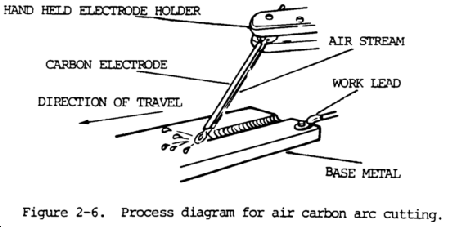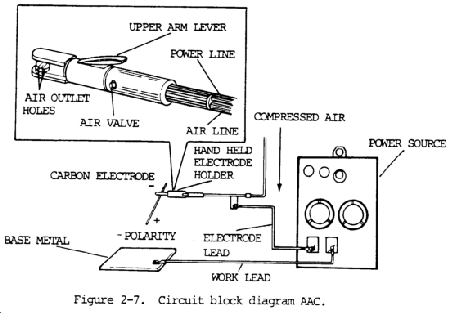2-12. ELECTRIC CIRCUITS
a. A shock hazard is associated with all electrical equipment, including extension lights, electric hand tools, and all types of electrically powered machinery. Ordinary household voltage (115 V) is higher than the output voltage of a conventional arc welding machine.
b. Although the ac and dc open circuit voltages are low compared to voltages used for lighting circuits and motor driven shop tools, these voltages can cause severe shock, particularly in hot weather when the welder is sweating. Consequently, the precautions listed below should always be observed.
(1) Check the welding equipment to make certain that electrode connections and insulation on holders and cables are in good condition.
(2) Keep hands and body insulated from both the work and the metal electrode holder. Avoid standing on wet floors or coming in contact with grounded surfaces.
(3) Perform all welding operations within the rated capacity of the welding cables. Excessive heating will impair the insulation and damage the cable leads.
WARNING
Welding machine, Model 301, AC/DC, Heliarc with inert gas attachment, NSN 3431-00-235-4728, may cause electrical shock if not properly grounded. If one is being used, contact Castolin Institute, 4462 York St. Denver, Colorado 80216.
c. Inspect the cables periodically for looseness at the joints, defects due to wear, or other damage. Defective or loose cables are a fire hazard. Defective electrode holders should be replaced and connections to the holder should be tightened.
d. Welding generators should be located or shielded so that dust, water, or other foreign matter will not enter the electrical windings or the bearings.
e. Disconnect switches should be used with all power sources so that they can be disconnected from the main lines for maintenance.
2-13. WELDING MACHINES
a. When electric generators powered by internal combustion engines are used inside buildings or in confined areas, the engine exhaust must be conducted to the outside atmosphere.
b. Check the welding equipment to make sur the electrode connections and the insulation on holders and cables are in good condition. All checking should be done with the machine off or unplugged. All serious trouble should be investigated by a trained electrician.
c. Motor-generator welding machines feature complete separation of the primary power and the welding circuit since the generator is mechanically connected to the electric rotor. A rotor-generator type arc welding machine must have a power ground on the machine. Metal frames and cases of motor generators must be grounded since the high voltage from the main line does come into the case. Stray current may cause a severe shock to the operator if he should contact the machine and a good ground.
d. In transformer and rectifier type welding machines, the metal frame and cases must be grounded to the earth. The work terminal of the welding machine should not be grounded to the earth.
e. Phases of a three-phase power line must be accurately identified when paralleling transformer welding machines to ensure that the machines are on the same phase and in phase with one another. To check, connect the work leads together and measure the voltage between the electrode holders of the two machines. This voltage should be practically zero. If it is double the normal open circuit voltage, it means that either the primary or secondary connections are reversed. If the voltage is approximately 1-1/2 times the normal open circuit voltage it means that the machines are connected to different phases of the three phase power line. Corrections must be made before welding begins.
f. When large weldments, like ships, buildings, or structural parts are involved, it is normal to have the work terminal of many welding machines connected to it. It is important that the machines be connected to the proper phase and have the same polarity. Check by measuring the voltage between the electrode holders of the different machines as mentioned above. The situation can also occur with respect to direct current power sources when they are connected to a common weldment. If one machine is connected for straight polarity and one for reverse polarity, the voltage between the electrode holders will be double the normal open circuit voltage. Precautions should be taken to see that all machines are of the same polarity when connected to a common weldment.
g. Do not operate the polarity switch while the machine is operating under welding current load. Consequent arcing at the switch will damage the contact surfaces and the flash may burn the person operating the switch.
h. Do not operate the rotary switch for current settings while the machine is operating under welding current load. Severe burning of the switch contact surfaces will result. Operate the rotary switch while the machine is idling.
i. Disconnect the welding machines from the power supply when they are left unattended.
j. The welding electrode holders must be connected to machines with flexible cables for welding application. Use only insulated electrode holders and cables. There can be no splices in the electrode cable within 10 feet (3 meters) of the electrode holder. Splices, if used in work or electrode leads, must be insulated. Wear dry protective covering on hands and body.
k. Partially used electrodes should be removed from the holders when not in use. A place will be provided to hang up or lay down the holder where it will not come in contact with persons or conducting objects.
l. The work clamp must be securely attached to the work before the start of the welding operation.
m. Locate welding machines where they have adequate ventilation and ventilation ports are not obstructed.
2-14. PROTECTIVE SCREENS
a. When welding is done near other personnel, screens should be used to protect their eyes from the arc or reflected glare. See paragraph 2-2 e for screen design and method of use.
b. In addition to using portable screens to protect other personnel, screens should be used, when necessary, to prevent drafts of air from interfering with the stability of the arc.
c. Arc welding operations give off an intense light. Snap-on light-proof screens should be used to cover the windows of the welding truck to avoid detection when welding at night.
2-15. PLASMA ARC CUTTING AND WELDING
a. Plasma arc welding is a process in which coalescence is produced by heating with a constricted arc between an electrode and the work piece (transfer arc) or the electrode and the constricting nozzle (nontransfer arc). Shielding is obtained from the hot ionized gas issuing from the orifice which may be supplemented by an auxiliary source of shielding gas. Shielding gas may be an inert gas or a mixture of gases; pressure may or may not be used, and filler metal may or may not be supplied. Plasma welding is similar in many ways to the tungsten arc process. Therefore, the safety considerations for plasma arc welding are the same as for gas tungsten arc welding.
b. Adequate ventilation is required during the plasma arc welding process due to the brightness of the plasma arc, which causes air to break down into ozone.
c. The bright arc rays also cause fumes from the hydrochlorinated cleaning materials or decreasing agents to break down and form phosgene gas. Cleaning operations using these materials should be shielded from the arc rays of the plasma arc.
d. When welding with transferred arc current up to 5A, safety glasses with side shields or other types of eye protection with a No. 6 filter lens are recommended. Although face protection is not normally required for this current range, its use depends on personal preference. When welding with transferred arc currents between 5 and 15A, a full plastic face shield is recommended in addition to eye protection with a No. 6 filter lens. At current levels over 15A, a standard welder's helmet with proper shade of filter plate for the current being used is required.
e. When a pilot arc is operated continuously, normal precautions should be used for protection against arc flash and heat burns. Suitable clothing must be worn to protect exposed skin from arc radiation.
f. Welding power should be turned off before electrodes are adjusted or replaced.
g. Adequate eye protection should be used when observation of a high frequency discharge is required to center the electrode.
h. Accessory equipment, such as wire feeders, arc voltage heads, and oscillators should be properly grounded. If not grounded, insulation breakdown might cause these units to become electrically "hot" with respect to ground.
i. Adequate ventilation should be used, particularly when welding metals with high copper, lead, zinc, or beryllium contents.
2-16. AIR CARBON ARC CUTTING AND WELDING
a. Air carbon arc cutting is an arc cutting process in which metals to be cut are melted by the heat of a carbon arc and the molten metal is removed by a blast of air. The process is widely used for back gouging, preparing joints, and removing defective metal.
b. A high velocity air jet traveling parallel to the carbon electrode strikes the molten metal puddle just behind the arc and blows the molten metal out of the immediate area. Figure 2-6 shows the operation of the process.

c. The air carbon arc cutting process is used to cut metal and to gouqe out defective metal, to remove old or inferior welds, for root gouging of full penetration welds, and to prepare grooves for welding. Air carbon arc cutting is used when slightly ragged edges are not objectionable. The area of the cut is small, and since the metal is melted and removed quickly, the surrounding area does not reach high temperatures. This reduces the tendency towards distortion and cracking. The air carbon arc can be used for cutting or gouging most of the common metals.
d. The process is not recommended for weld preparation for stainless steel, titanium, zirconium, and other similar metals without subsequent cleaning. This cleaning, usually by grinding, must remove all of the surface carbonized material adjacent to the cut. The process can be used to cut these materials for scrap for remelting.
e. The circuit diagram for air carbon arc cutting or gouging is shown by figure 2-7. Normally, conventional welding machines with constant current are used. Constant voltage can be used with this process.

f. When using a constant voltage (CV) power source precautions must be taken to operate it within its rated output of current and duty cycle.
g. Alternating current power sources having conventional drooping characteristics can also be used for special applications. AC type carbon electodes must be used.
h. Special heavy duty high current machines have been made specifically for the air carbon arc process. This is because of extremely high currents used for the large size carbon electrodes.
i. The air pressure must range from 80 to 100 psi (550 to 690 kPa). The volume of compressed air required ranges from as low as 5.0 cu ft/min. (2.5 liter/rein.) up to 50 cu ft/min. (24 liter/min.) for the largest-size carbon electrodes.
j. The air blast of air carbon arc welding will cause the molten metal to travel a very long distance. Metal deflection plates should be placed in front of the gouging operation, and all combustible materials should be moved away from the work area. At high-current levels, the mass of molten metal removed is quite large and will become a fire hazard if not properly contained.
k. A high noise level is associated with air carbon arc welding. At high currents with high air pressure a very loud noise occurs. Ear protection, ear muffs or ear plugs must be worn by the arc cutter.
Authorization Letter


